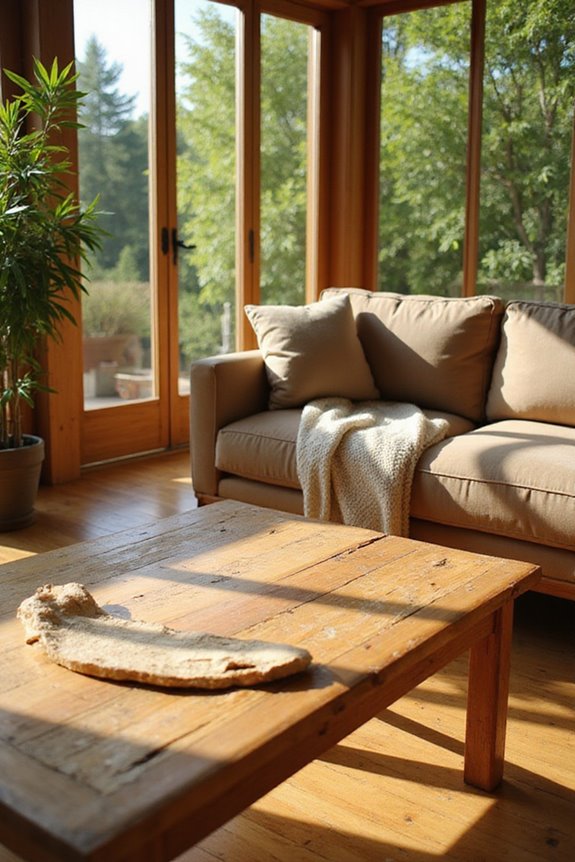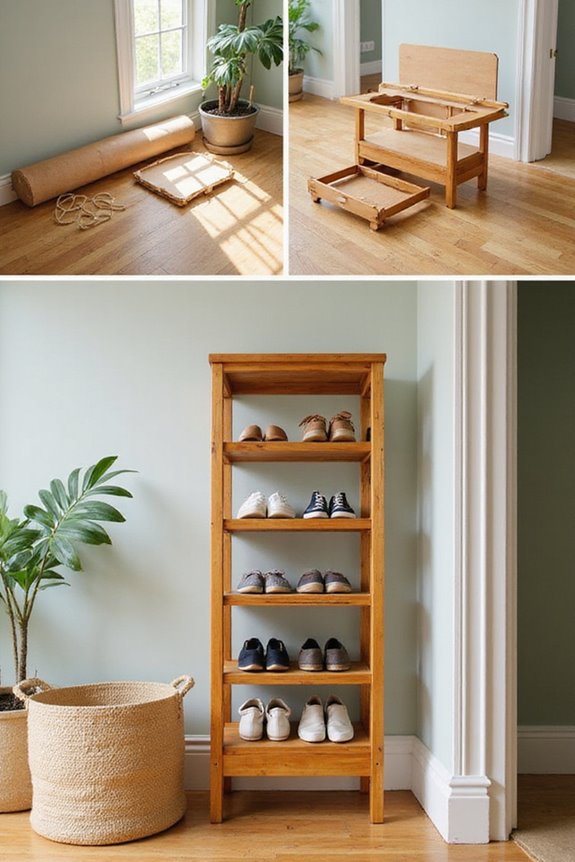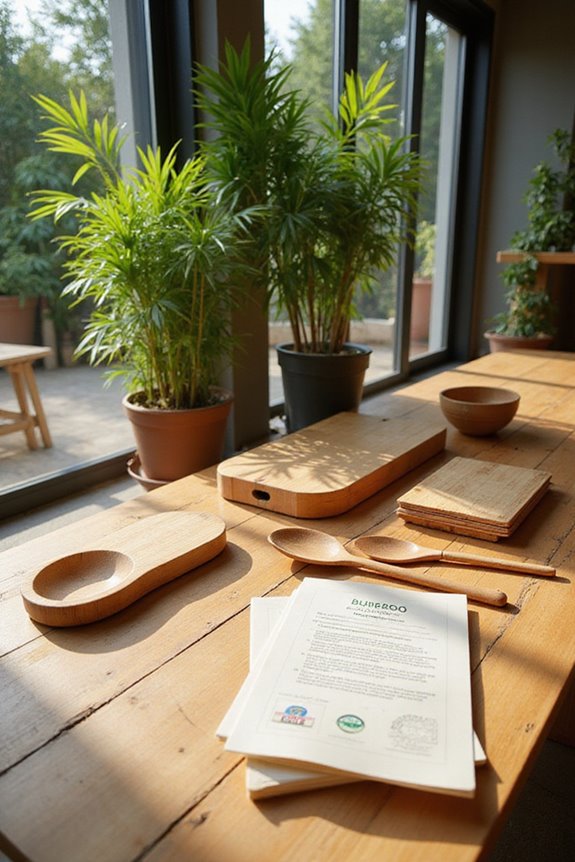Yes, many bamboo furniture products undergo chemical treatments. These treatments improve durability and insect resistance. Common options include Copper Chrome Arsenic (CCA) for outdoor use, and Boron-Based Treatings, which are safer for indoor settings. However, it’s essential to evaluate the health and environmental impacts of these chemicals. Choosing non-toxic treatments can promote safety and sustainability. There’s much more to explore on this topic, including alternatives and specific treatment processes that enhance bamboo furniture longevity.
Key Takeaways
- Yes, bamboo furniture is often chemically treated to enhance durability and protect against pests and environmental factors.
- Common treatments include Copper Chrome Arsenic (CCA), Copper Chrome Boron (CCB), and boron-based treatments, each serving different safety and durability needs.
- Soaking and pressure techniques are standard methods used to apply chemical treatments effectively to bamboo.
- Health and environmental safety vary by treatment, with some chemicals posing risks if not handled or disposed of properly.
- Consumers should research treatment methods and product certifications to make informed choices regarding bamboo furniture safety.
Common Chemical Treatments for Bamboo Furniture
When it comes to treating bamboo furniture, several chemical options are available to enhance its durability and resistance to pests. Let’s explore some common bamboo preservation methods.
- Copper Chrome Arsenic (CCA): This heavy-duty treatment lasts over 50 years but has toxic components. It’s best for outdoor use.
- Copper Chrome Boron (CCB): A safer alternative to CCA, with lower health risks and effective for indoor and outdoor applications.
- Boron-Based Treatments: These non-fixing options are non-toxic and affordable, increasing durability without complex processes.
- Zinc Chrome Treatment: Useful for outdoor bamboo, but it may affect paint adhesion.
Each method has varying treatment effectiveness, so choosing the right one depends on your specific needs and environment. Additionally, it’s essential to ensure that the bamboo is treated for moisture and UV resistance, as this significantly impacts its longevity and performance outdoors.
Physical and Natural Alternatives to Chemical Treatments
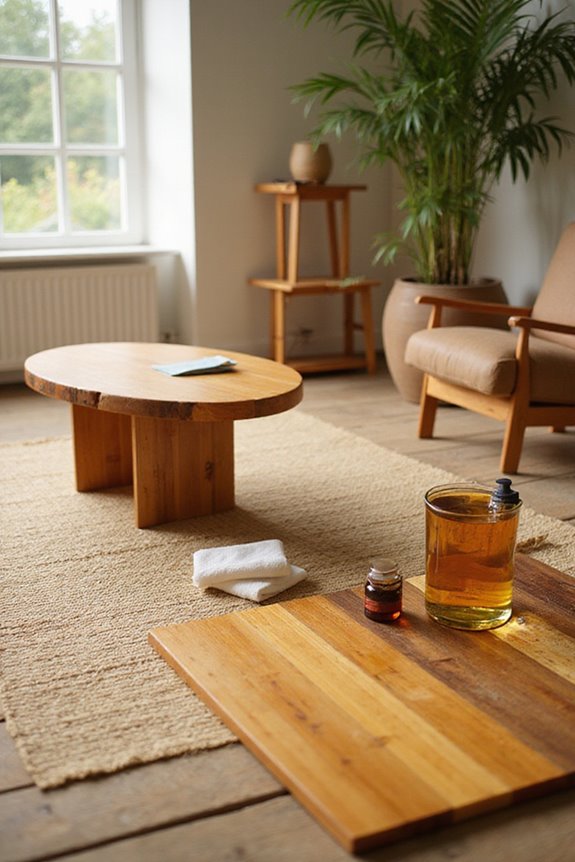
Bamboo furniture can benefit from physical and natural alternatives to chemical treatments. These methods support natural preservation and enhance bamboo maintenance. For instance, using neem or cedarwood oil diluted in water can repel insects naturally. Regular cleaning with a damp cloth and dry brushing helps prevent dirt and fungi buildup.
We can also utilize heat treatments, like soaking bamboo in heated water, to enhance durability without chemicals. Applying protective coatings or natural stains offers additional surface protection. Additionally, bamboo accessories made from sustainable materials contribute to an eco-friendly lifestyle.
Moreover, regular inspections for any signs of mold or fungal infections are essential. By taking these steps, we can guarantee our bamboo furniture remains beautiful and lasts longer while staying environmentally friendly.
Processes and Protocols for Chemical Treatment
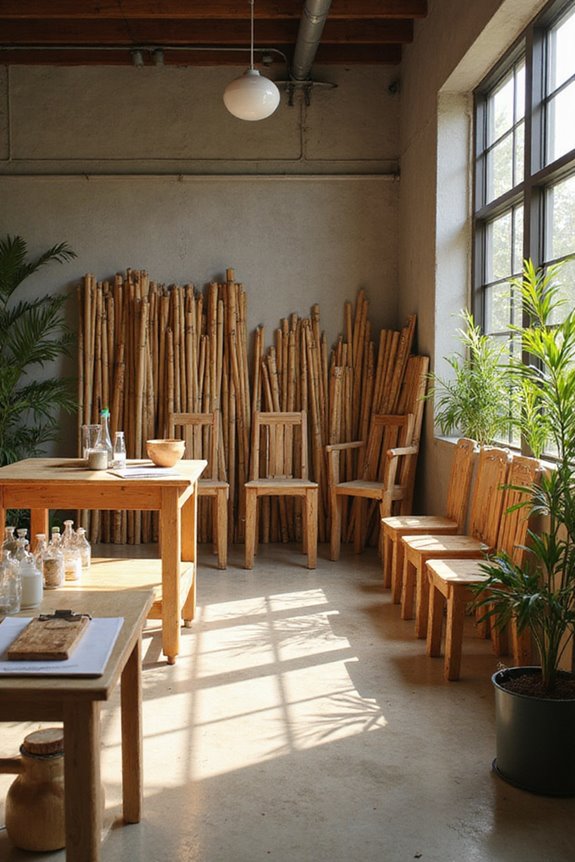
Chemical treatments play an essential role in preserving bamboo furniture and enhancing its longevity. We often use soaking methods, where bamboo is immersed in chemical solutions like borax or boric acid for up to 21 days. This process helps eliminate starches and deter insects, making the bamboo stronger for furniture making.
On the other hand, pressure techniques involve vacuum-pressure cycles that push preservatives deep into the bamboo. This method is faster and more effective, ensuring thorough protection against mold and pests.
Both methods may include pre-treatment steps, like creating small holes in bamboo nodes, to facilitate better absorption. Following these processes, proper drying is vital to fix the chemicals inside and reduce moisture content, preventing future damage.
Effects of Chemical Treatments on Bamboo Properties

Understanding how chemical treatments affect bamboo properties is essential for anyone involved in bamboo furniture making. The treatment impacts can be significant. For instance, using 20% sodium hydroxide can stiffen bamboo by about 59%, enhancing certain mechanical properties. However, bleaching may weaken tensile strength due to lignin breakdown, leading to brittle fibers.
Moreover, treatments like tung oil thermal treatment not only improve durability but also enhance the aesthetic appeal, enriching color depth. It’s important to balance treatment strength; over-treatment can degrade structural integrity while under-treatment may limit durability gains. By understanding these effects, we can make informed decisions that enhance the beauty and longevity of our bamboo furniture. Additionally, bamboo is a rapidly renewable resource, making it a sustainable choice for eco-conscious consumers.
Safety and Environmental Considerations in Treatment
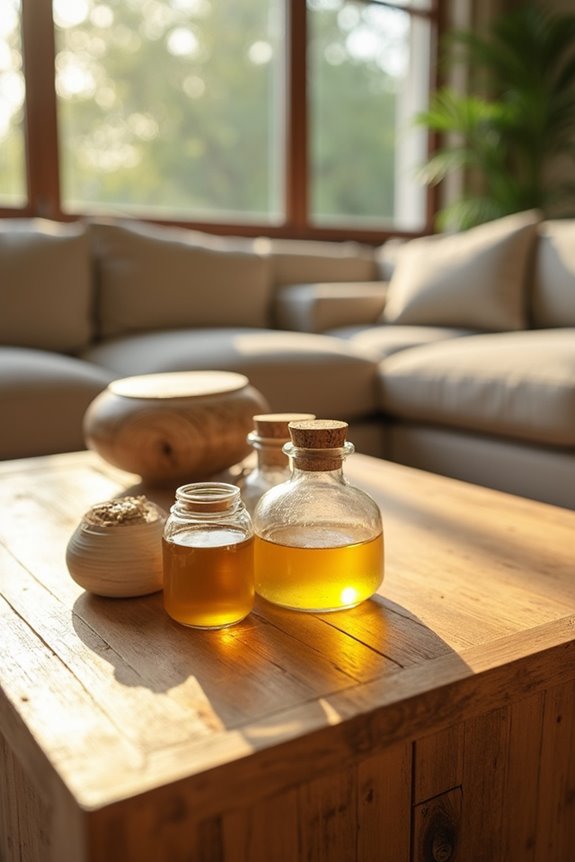
When we consider the safety and environmental impacts of treating bamboo, it’s essential to choose methods that protect both our health and the planet. Here are some key points to keep in mind:
- Safety Assessments: Treatments using borax and boric acid are non-toxic and pose minimal health risks. They’re safe for indoor use and have low environmental impact.
- Environmental Impact: Heavy metal preservatives like CCA and CCB can contaminate soil and water if disposed of improperly. This can lead to long-term environmental hazards.
- Natural Alternatives: Non-chemical methods, like using natural oils, are safer but may not provide the same durability. Additionally, choosing eco-friendly materials can enhance the overall sustainability of your home design while minimizing harmful effects.
Industrial vs. Traditional Bamboo Treatment Techniques
Bamboo treatment techniques vary considerably between industrial and traditional methods, each with its own advantages and limitations.
- Industrial Methods:
- Pressure Treatment: This method uses vacuum pressure to infuse preservatives deeply into the bamboo. It’s faster and guarantees durability.
- Bleaching and Caramelisation: These processes alter color while enhancing resistance to pests.
- Soaking Methods: Prolonged soaking in water helps reduce starch content, making bamboo less appealing to pests.
- Smoking: A low-tech approach that repels pests but may be less effective for heavy-duty use.
While industrial techniques often provide quicker results, traditional methods connect us with nature and ancient practices. Each approach offers unique benefits that can fit different needs, making it essential to consider the durability of bamboo in relation to the intended use.
The Role of Chemical Treatment in Bamboo Furniture Longevity
Chemical treatment plays an essential role in enhancing the longevity of bamboo furniture. Here are some key treatment benefits that we should consider:
- Increased Resistance: Treatments like boron-based preservatives greatly improve resistance to pests and fungal decay. This means our furniture lasts longer and stays in good condition.
- Moisture Control: Properly treated bamboo minimizes moisture-related degradation. This helps prevent shrinkage and cracking during use, crucial longevity factors.
- Durability Enhancement: Vacuum pressure methods force preservatives deep into bamboo. This provides robust protection, extending the furniture’s service life. Additionally, the moisture resistance of bamboo ensures that treated pieces perform well in humid areas, further enhancing their durability.
Evaluating the Necessity of Chemical Treatment for Bamboo Furniture
Evaluating the necessity of chemical treatment for bamboo furniture is essential for ensuring its durability and usability. Bamboo naturally attracts pests due to its sugars and starches, making treatment effectiveness vital. Chemical preservatives like borax and boric acid help prevent decay and insect damage, increasing pest resistance.
- Untreated bamboo is prone to mold and insects, especially in humid areas.
- Chemical treatments extend furniture lifespan by preventing biodegradation.
- Some treatments allow bamboo to endure outdoor conditions, which untreated bamboo cannot handle.
Natural alternatives, like tung oil, offer safer options without harsh chemicals. By weighing the benefits of chemical treatment against potential health concerns, we can make informed choices for sustainable bamboo furniture.
Frequently Asked Questions
How Can I Identify Chemically Treated Bamboo Furniture?
When identifying bamboo finishes, we can look for documentation on bamboo treatment methods and check for uniformity in color or texture. Consulting manufacturers helps guarantee we’re choosing safe and eco-friendly options for our homes.
Is Chemically Treated Bamboo Furniture Safe for Indoor Use?
When we invite bamboo furniture into our homes, we’re embracing nature’s elegance. If it’s treated with borax-boric acid, we can enjoy vibrant indoor air quality while ensuring our family’s safety and comfort together.
Can Bamboo Furniture Be Treated Multiple Times?
Yes, we can treat bamboo furniture multiple times using various preservation techniques. These treatments enhance furniture longevity factors, ensuring durability and protection against pests, helping us maintain our cherished pieces for years to come.
What Are the Signs of Chemical Treatment Wear?
We’ve all admired the beauty of bamboo furniture, but let’s be mindful of chemical treatment signs. Fading, peeling, or cracking can reveal durability issues, reminding us to cherish and care for our eco-friendly treasures.
Are There Certifications for Eco-Friendly Bamboo Furniture?
When exploring eco-friendly bamboo furniture, we should look for eco labels like FSC and GREENGUARD. These certifications guarantee sustainable sourcing and low chemical emissions, helping us make responsible choices for our homes and the planet.

